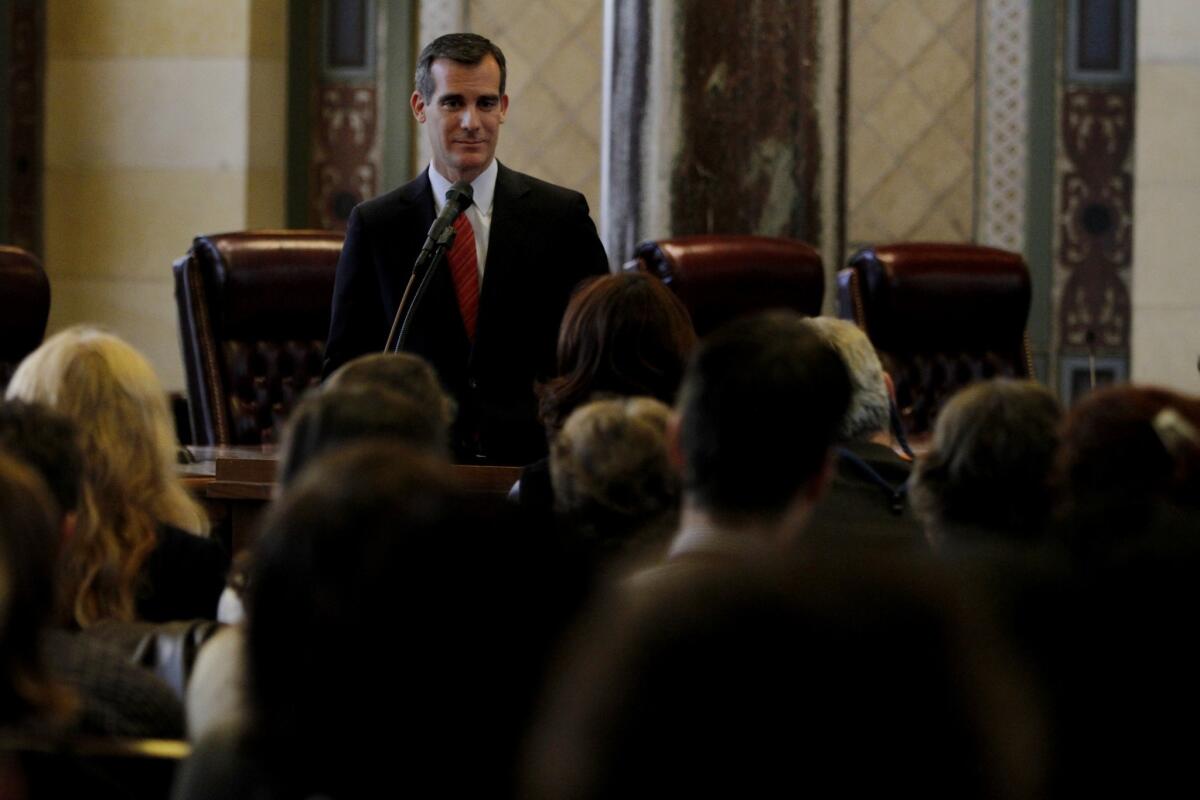Putting LAFD’s hiring practices to the test

- Share via
I’m guessing that if you call 911 to report a fire in Los Angeles, you probably wouldn’t want me showing up with a hose and a helmet. But just in case I had an untapped aptitude for putting out blazes, I decided to try my hand at the sample test questions posted for would-be firefighters on a city website.
The LAFD could always use a few more good men and women, after all. The rank and file may be top notch, but in the upper echelons, it’s been one white-hot controversy after another regarding the 911 system and misleading claims about response times. Now my colleagues have reported on a convoluted hiring process, and a long-awaited consulting report landed with a small explosion this week. It called for a major overhaul to deal with “cultural, organizational, process and technology challenges which seriously impair the department’s performance.”
Please, though, before you pass judgment, keep one thing in mind:
None of this is Mayor Eric Garcetti’s fault.
“This problem may have been caused before I took office,” Garcetti said in a statement Tuesday announcing a new investigation of LAFD, “but as mayor, I’m going to fix it.”
A day earlier, when I raised questions about whether the written exam for firefighter applicants was too easy, one of Garcetti’s aides noted that the test “predates our admin.”
Of course, it doesn’t predate his 12 years as a councilman, half of them as City Council president. But blaming your predecessor for problems, while promising to courageously lead the reforms, is a hallowed political tradition.
Now, back to the hiring process. As Robert Lopez and Ben Welsh reported, a crush of applicants tried to get into the fire academy last year. Nearly 10,000 people tested for just 70 openings, which could have been a good thing if the city’s fire and personnel departments had also tried to identify the best candidates.
Instead, without notifying job-seekers, the city accepted applications from those who passed the test only if their forms were submitted electronically during the first 60 seconds of the filing period, shutting out all the others so it wouldn’t have to review thousands of submissions. Even if applicants had firefighting or paramedic training, they were out of luck if they didn’t hit the send button fast enough.
In the end, roughly 25% of the lucky applicants accepted into the academy were related to LAFD employees.
One word comes to mind:
Hmmmmmmmm.
As for the written test, it was a pass-fail deal, so an applicant who aced the exam had no advantage over an under-achiever who barely made the grade. And the bar does not appear to have been set particularly high. About 6,500 applicants, or nearly 70% of the initial pool, passed the multiple choice and true-false test. You had to pass that test and a tough physical exam to be considered for hire.
I couldn’t get my hands on an official written exam, because those are not for public distribution. But the website joinlafd.org provides links to “sample questions,” and after perusing them, it’s hard to believe 3,000 people flunked.
As an example of the format, joinlafd.org offers this:
The number of days in a year is:
A. 365
B. 366
C. 367
D. 368
“The answer you should choose is A,” the instructions say, “because it is the one which is most often correct. Choice B is true for leap years, but most years have 365 days.”
If you passed that hurdle, let’s click on the “LAFD Ready Now! Written Test Prep.”
And here we go:
“A man was carrying balloons but the wind blew 5 away. He has 6 balloons left. How many did he start with?”
Does the man live on Sesame Street?
“Jill and I have 9 feet of licorice,” states another question. “I have 7 feet, how many feet does Jill have?”
Here’s a better question: Unless Jill’s hair is on fire, why would someone who wants to be a firefighter care? Wouldn’t it be better to pose the question in a way that’s more specific to the job?
For instance:
“Jill is choking on 2 feet of licorice. Should you begin chest compressions, perform the Heimlich maneuver, scold her for eating so much candy or run the fire hose full blast to wash down the licorice?”
The staff at the city’s personnel department told me those questions were designed by the Fire Department as general guidelines for recruits. But for a more realistic sense of the test, I should go to joinlafd.org and click on “tips and sample questions.”
Those are a little harder, with reading comprehension questions actually related to firefighting. But as the father of an elementary school student, I think I can say the math is at about the fifth-grade level, give or take.
For instance:
“The fraction of 2/3 is most nearly equal to what decimal?”
A. .23
B. .33
C. .67
D. .80
Another question asks:
“How many fluid ounces equal one pint?”
If it’s a pint of Guinness, does the foam count as liquid?
And since I’m asking the questions now, here’s another:
Should the LAFD:
A. Make the written test harder?
B. Make it more relevant?
C. Grade it on a scale rather than pass-fail?
D. All of the above?
The correct answer is D.
Interim Fire Chief James Featherstone has a lot to do, given the mandate for major departmental reforms. But a review of the hiring process is definitely on his list, he said Tuesday.
“Will I take a look at the written exam?” he asked. “Yes, I will.”
As for how many ounces in a pint, his response time was excellent.
“A pint’s a pound the world around.”
More to Read
Sign up for Essential California
The most important California stories and recommendations in your inbox every morning.
You may occasionally receive promotional content from the Los Angeles Times.














